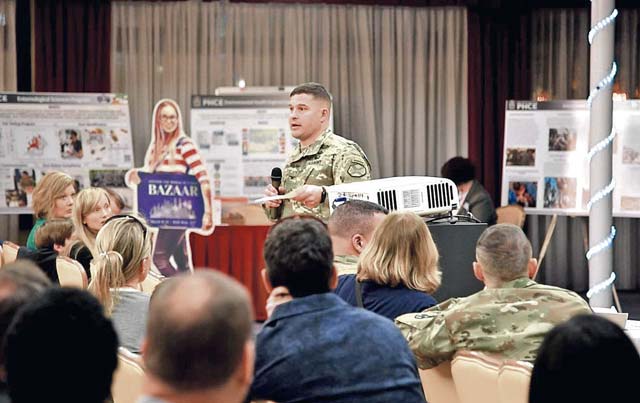
Safety, housing and availability of resources at Sembach were a few of the topics discussed during the U.S. Army Garrison Rheinland-Pfalz Town Hall at Armstrong’s Club on Vogelweh Housing, Feb. 19.
Col. Jason T. Edwards, USAG RP commander, hosted the town hall to find out what is important to community members and to see where improvements can be made.
To do this, a survey was conducted a week prior to the event to rate customer satisfaction in the areas of Public Works, Emergency Services, Department of Defense Education Activity schools and Family and Morale, Welfare and Recreation services. The assessment provided garrison leadership with a data-driven gauge of what topics were foremost in the minds of military community residents. Subject matter experts from several organizations were on hand to help answer questions, provide explanations and offer background on specific topics identified by the survey.
In addition, the Army’s Senior Responsible Officer for the Kaiserslautern Military Community, Maj. Gen. Steve Shapiro, commander of 21st Theater Sustainment Command, kicked off the town hall with an overview of housing and barracks concerns across the Army and how those issues relate to Soldiers and Families in Europe.
“The intent of this town hall is to find out if there are any issues or problems within the community,” Edwards said to several hundred community members at the club for the event. “We want to identify what we need, what we should change and what’s not being met. We’re also here this evening to provide our community with up-to-date information on what is happening within the garrison based on your inputs to last week’s survey regarding the services we provide.”
Safety was a major priority for the community, and the garrison received high marks for on-post safety, military police patrols on installations, emergency data awareness and the use of social media to deliver emergency and weather-related messages.
Another area of concern within the military community was the lack of housing during the summer relocation season and finding homes within the Joint Travel Regulation’s authorized window for temporary lodging for military families.
Finding a house during peak season is tough, said U.S. Air Force Lt. Col. Kathryn Kilker, 86th Civil Engineer Group commander, who explained the house-hunting process at the event. Newcomers must check in with the housing office and view at least two homes during the initial 10-day window, Kilker explained. Service members can request more time. During the second and third 10-day windows, they must look at five homes per time frame. Once the amount of time extends beyond 30 days, Soldiers must request an extension to U.S. Army in Europe.
“One way to help when you are putting in your Temporary Housing Allowance extension requests is to show that you are aggressively looking at houses within your entitlement,” she said. “People can also make a short-term lease agreement with a TLA, if they are available, and they are accepting the OHA (Overseas Housing Allowance) rate. That is a really great opportunity for people to extend their time, while using your OHA on [a TLA] while you look for your actual permanent location.”
A lack of a commissary, amenities and activities at Sembach Kaserne were additional topics of concern voiced at the town hall.
“I was in the former commissary last week. As it stands right now, there was a business model that was completed a couple of years ago about financially sustaining a commissary (at Sembach),” Edwards said, explaining that with two other large commissaries within the KMC the Defense Commissary Agency made a business decision to shutter the Sembach facility. “What was brought up during our first Community Leadership Council was to generate a ‘Grab and Go’ for fruit and vegetables, milk and those types of things. During the week, have the basics available and ramp up on the weekend to get your full load of groceries. The point is to have some place where you can buy [groceries] to sustain you.”
The commander also said he’s looking at several options with various agencies to create more activities and provide additional food options for those living and working on Sembach.
“We have to find ways to meet the needs of our Sembach single Soldiers and families that are financially sustainable and provide a service,” Edwards said.
While garrison library and post office hours received high marks, fitness centers received requests for 24-hour access and also showed a need for improvement.
“What we are doing is taking the functional fitness area on Rhine Ordnance Barracks and moving all the fitness center equipment in there and putting in a basketball court. Then you will have a place where you can have family fitness in what is now the current gym,” the commander said. “The paperwork has been submitted to make that move, but we have to see how long it will take to accomplish that.”
Edwards also mentioned the garrison is exploring options to implement 24-hour access at Army fitness centers using card readers but that “there is an [Information Technology] requirement that we have to get approved.”
“I appreciate everyone attending today. I’m happy about the feedback we received, and I know we have a lot of work to do to make our garrison a better place to live and work,” the commander concluded.
USAG RP will address Baumholder Military Community concerns at a town hall at the Wagon Wheel Theater on Smith Barracks, Feb. 26.


